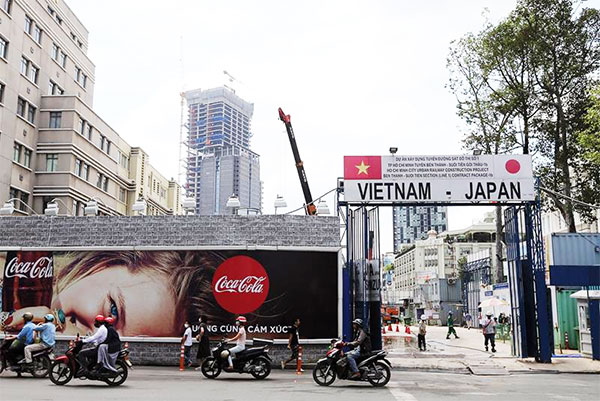|
HCM City
metro projects short on capital
The two urban railway projects Ben Thanh-Suoi Tien and Ben Thanh-Tham
Luong, which were in the portfolio of important projects receiving
national budget funding of at least VND10 trillion ($438 million) each,
are confronted with a shortage of capital.

Metro line 1 in trouble
A
shortage of capital is the key problem of both Line 1 (Ben Thanh – Suoi Tien)
and Line 2 (Ben Thanh – Tham Luong) urban railway projects.
The
Ho Chi Minh City People’s Committee is the developer responsible for the two
projects.
At
the Metro Ben Thanh-Suoi Tien project, the developer has been slow to pay
contractors and may have to pay interest on late payment.
According
to a report submitted to the Ministry of Transport at the beginning of March
2017 by Le Van Khoa, deputy chairman of the Ho Chi Minh City People’s
Committee, the payments for four construction packages have been delayed
since September 2016.
The
reason is that the ODA capital provided for Ho Chi Minh City was only
VND592.693 trillion ($26 million), a much lower amount compared to the VND1.95
trillion ($85.17 million) payable for the contractors.
To
deal with the current shortage, Ho Chi Minh City had to withdraw VND600
billion ($26.3 million) from the city budget to pay in advance for the
consulting companies and contractors.
With
the current progress, although package No. 1a was started in November 17,
2016, the authority cannot pay the contractors as promised.
Accordingly,
by February 15, 2017, Ho Chi Minh City’s Urban Railway Management Boardwould
have to pay in advance the amount of VND571 billion ($25 million).
In
case the developer fails to pay, the contract will be extended, which will
result in numerous incurred additional expenses.
Khoa
said that the estimated ODA capital for Metro Line 1 is VND2.119 trillion
($93 million) in 2017.
However,
the project’s capital has not been added to the country’s plan on using ODA,
which significantly affected the construction progress.
By
the end of February 2017, package No. 1b, used for the constructions of the
stations between Saigon Opera House and Ben Thanh, was 41 per cent completed,
while package No. 2 toconstruct the 17.1-kilometre stretch plus depots
between Ba Son and Binh Duong was 65 per cent completed.
Package
No. 3 for the purchase of electromechanical equipment, locomotives,
carriages, and railway tracks was 12 per cent completed.
In
general, the total disbursement of the project is VND10.9 trillion ($477
million), of which VND9.712 trillion ($425 million) is sourced from ODA.
If
the Japanese and Vietnamese contractors progress as scheduled, the total
value of the completed parts in 2017 may reach VND5.320 trillion ($233
million).
“The
project should receive more ODA. It is essential to ensure the project’s
progress as committed, as well as to avoid other incurred expenses, late
payment penalties, and lawsuits from foreign contractors,” said the report.
The
19.7-kilometre Ben Thanh-Suoi Tien Line goes through District 1 (Binh Thanh),
District 2 (Thu Duc), District 9, and ends in Binh Duong Province (Di An
District).
Of
the total, the underground parts are 2.6 kilometres, and the overhead parts
are 17.1 kilometres long.
The
total investment after three adjustments has increased from VND14.415
trillion ($631 million) to VND47.325 trillion ($2.07 billion).
The
construction of the overhead part has been on-going since August 2012.
The
maximum speed along the line will be 80 kilometres per hour on the
underground sections and 110 kilometres per hour on the bridge. It is
forecasted to begin test runs in 2019 and be officially put into operation in
2020.
Metro Line 2 in a worse spot
Although
Metro Line 1 is in slow progress, at least it has a forecasted launching
period, while Line 2, which is also managed by Ho Chi Minh City’s Urban
Railway Management Board, is struggling with investment adjustments and
updating bid documents.
Accordingly,
the total investment of Metro Ben Thanh-Tham Luong is proposed to be
VND47.605 trillion ($2.152,36 million), an increase of 56.6 per cent compared
to the initial planned investment in 2010.
The
three biggest increases derive from land clearance, which rose from $119.38
million to $197.88 million; installation and purchase, which went from
VND748.11 billion ($33 million) to VND1.198 trillion ($52 million); and
reserves, which increased from $263 million to $368 million.
By
the end of February 2017, after six years of construction works, the
disbursement was only VND700 billion ($31 million), including VND572 billion
($25 million) of ODA capital, which is equivalent to three per cent of the
expected sum total.
A
representative of the Ho Chi Minh City Urban Railway Management Board
admitted that implementation was slow compared to the promised schedule
because the design has been adjusted.
Additionally,
the different instructions issued by the sponsors and the Vietnamese
government on picking contractors and the elongated time for collecting
feedback from sponsors also contributed to the slow going.
As
the most important Metro line in Ho Chi Minh City, the Ben Thanh-Tham Luong
line will go from the new urban area Thu Thiem (District 2) and end in An
Suong (District 12). It is forecasted that by 2025, it will handle 481,700
passengers a day.
Besides
the sharp increase in capitalisation, the launch will be delayed to 2024,
despite initial promises to complete works by the end of 2016, as specified
in Decision No 4474/QD – UBND approved by the Ho Chi Minh City People’s
Committee.
“The
Ho Chi Minh City People’s Committee should review the implementation progress
of each package used in these projects and have appropriate solutions to
avoid the extension of process, which may lead to an increase in total
investment, administration, and interest expenses, exchange rate risks, and
fluctuations in construction material prices,” an expert said.
VIR
|
Thứ Hai, 10 tháng 4, 2017
Đăng ký:
Đăng Nhận xét (Atom)
Không có nhận xét nào:
Đăng nhận xét